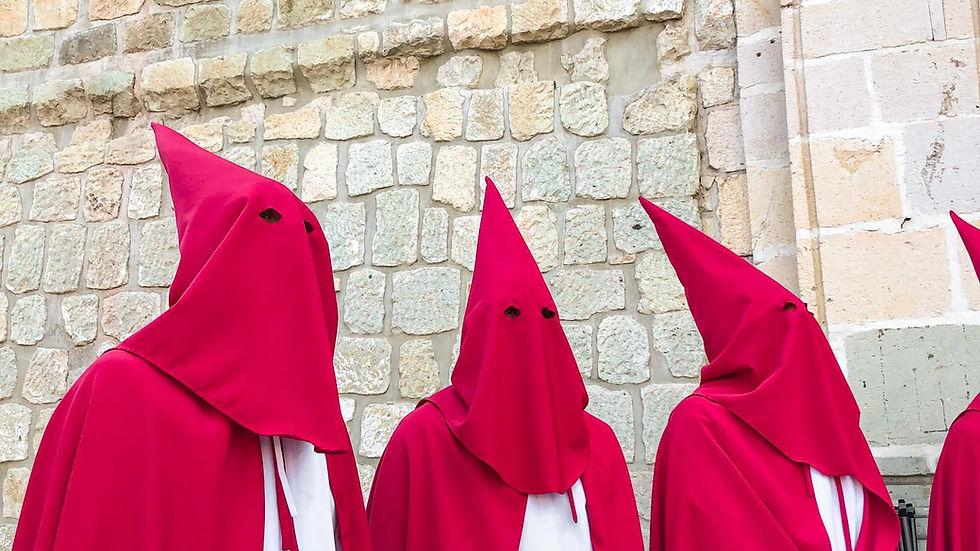Discover Semana Santa en Oaxaca
- chtopete
- Apr 7
- 4 min read
Updated: Jun 4
A Cultural and Language Experience for Spanish Students: Semana Santa in Oaxaca
Semana Santa (Holy Week) in Oaxaca is a powerful and enriching time to experience Mexican culture. For Spanish language learners, it provides an incredible opportunity to connect language with lived traditions, deepen vocabulary, and participate in rituals that shape daily life in Oaxaca.
La Cuaresma: A Culinary and Cultural Journey

The season of Cuaresma (Lent) begins on Miércoles de Ceniza (Ash Wednesday) and lasts for 40 days leading up to Holy Thursday. Many people in Oaxaca refrain from eating meat during this time, particularly on Fridays. They instead turn to traditional dishes made with fish, vegetables, and local ingredients. This dietary shift has inspired a unique Oaxacan culinary tradition rich in symbolism and flavor.
At Instituto Cultural Oaxaca, our Semana Santa cooking workshop dives into these special recipes. Students enhance their Spanish vocabulary for food and cooking while getting hands-on experience preparing dishes like tortitas de camarón, nopal salad, and mole de vigilia. Cooking together in Spanish creates a memorable and immersive learning environment.
Key Vocabulary
Cuaresma – Lent
Miércoles de Ceniza – Ash Wednesday
vigilia – the practice of avoiding meat
pescado – fish
platillo típico – traditional dish
Cultural Highlights of Semana Santa in Oaxaca
Semana Santa is a time filled with rich traditions and cultural expressions. Each event offers Spanish learners a chance to deepen their understanding of the language while connecting with culture.
El Viernes de Dolores and the Altar de Dolores

The Friday before Palm Sunday, known as El Viernes de Dolores, is dedicated to La Virgen de Dolores (Our Lady of Sorrows). Families, churches, and public spaces set up altares de Dolores, which are beautifully decorated altars. These altars feature purple cloth, bitter oranges, wheatgrass, flowers, mirrors, and seven cups representing each of the seven sorrows of the Virgen. They reflect both pain and hope and are akin to the ofrenda or altar de muertos during Día de los Muertos.
This is a wonderful opportunity for Spanish learners to explore vocabulary related to religion, poetry, and expression.
Key Vocabulary
Altar de Dolores – altar for Our Lady of Sorrows
la Virgen de Dolores – Our Lady of Sorrows
reflejo – reflection
tristeza – sorrow
Estandartes y Relicarios
During Semana Santa, communities showcase intricate estandartes (banners) and relicarios (reliquaries) that tell stories through rich religious iconography. These artifacts are passed down through generations and serve as vibrant expressions of faith.

Walking through these displays feels like entering a living museum. This setting is perfect for developing descriptive Spanish and expanding vocabulary related to art, religion, and history.
Key Vocabulary
estandarte – banner
relicario – reliquary
procesión – procession
símbolo – symbol
Domingo de Ramos (Palm Sunday)
Palm Sunday celebrates Jesus' entry into Jerusalem. In Oaxaca, the streets come alive with markets selling woven palm crosses and figures. Joining a Palm Sunday mass or procession allows participants to experience the community's faith actively and to practice their Spanish listening and comprehension skills.
Key Vocabulary
palma – palm
cruz – cross
bendecir – to bless
Viernes Santo and the Procesión del Silencio

Viernes Santo (Good Friday) is one of the week's most solemn days. After dark, the Procesión del Silencio moves quietly through Oaxaca City. Participants wear black robes and hoods, with only the sound of drums and shuffling feet breaking the silence. The atmosphere is deeply moving, perfect for reflection and cultural observation.
Key Vocabulary
silencio – silence
luto – mourning
devoción – devotion
A Fun Cultural Connection: Chía Pets and Ancient Traditions
Did you know that the popular Chía Pet connects to ancient Mesoamerican traditions? People in Mexico sprout semillas de chía (chia seeds) in clay figurines. The planting occurs on Samaritan Friday so that the chia can grow into decorative plants. This practice coincides with Los Altares de Dolores, and the sprouts symbolize new life and hope. So, the next time you see a Chía Pet, remember its deep-rooted tradition.
Key Vocabulary
semilla – seed
brotes – sprouts
esperanza – hope
Engaging with Semana Santa
Semana Santa in Oaxaca is more than just a religious event; it encompasses a sensory, linguistic, and emotional journey. At Instituto Cultural Oaxaca, we celebrate this season uniquely, starting with El Viernes de la Samaritana, a cherished local tradition. During this time, people share refreshing drinks made from fruits and flowers as a gesture of kindness and hospitality.
For two immersive weeks, ICO offers the Semana Santa Cultural Workshop. This hands-on experience allows participants to explore the rich cultural expressions of Holy Week. You will set up an Altar de Dolores and gain firsthand insight into the traditions that make this season in Oaxaca so special. Combined with language classes and cultural outings, it’s an unforgettable way to improve your Spanish while engaging deeply with the culture.
Learn Spanish where tradition lives. To learn more about our Spanish programs and cultural workshops, visit www.icomexico.com. ¡Te esperamos en Oaxaca!
Conclusion
Participating in Semana Santa is an immersive experience that connects learners to the heart of Oaxacan culture. The blend of religious significance and community spirit makes it a unique backdrop for anyone eager to improve their Spanish. Join us for an unforgettable journey into the soul of Oaxaca this Holy Week.




Comments